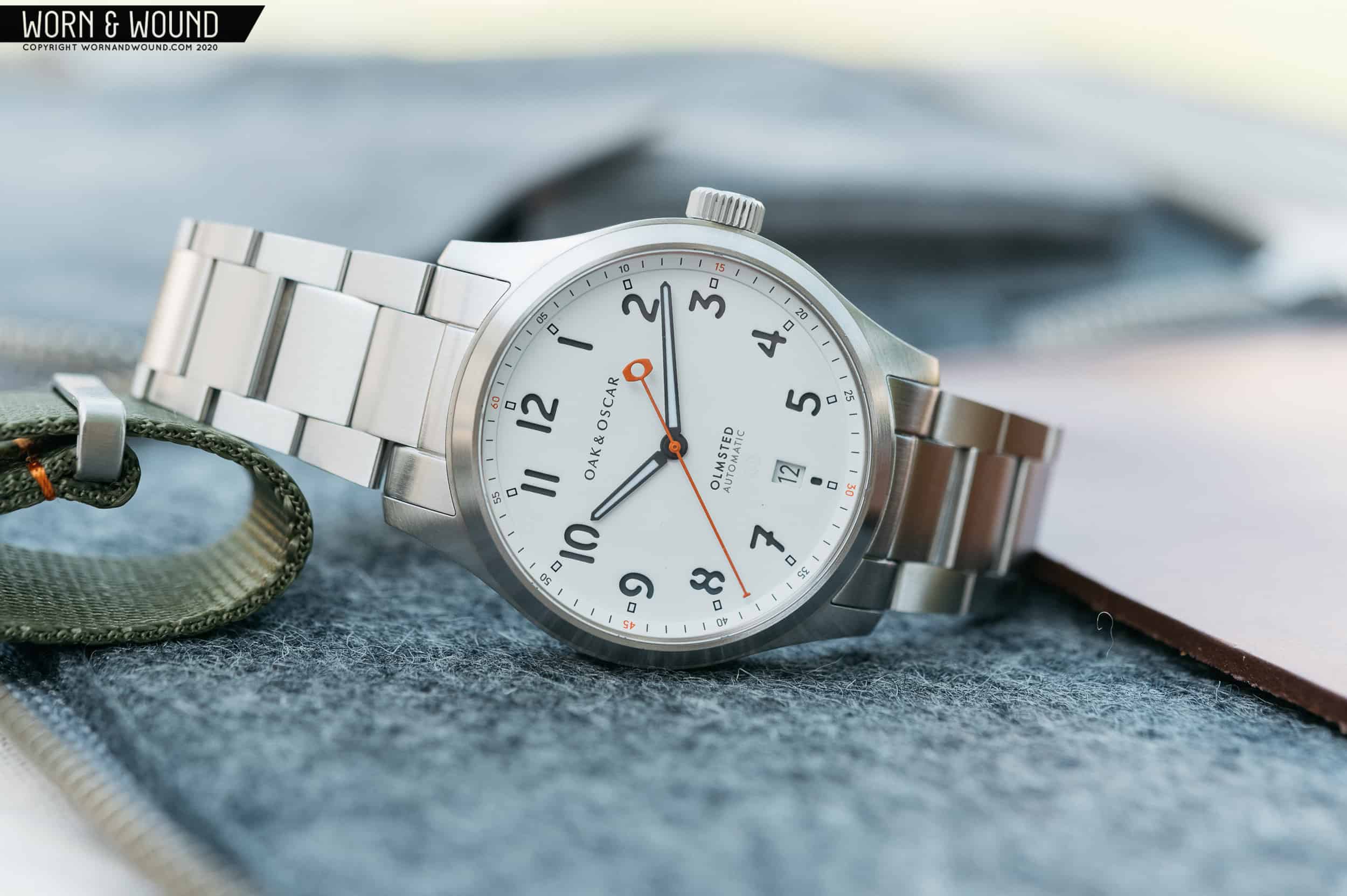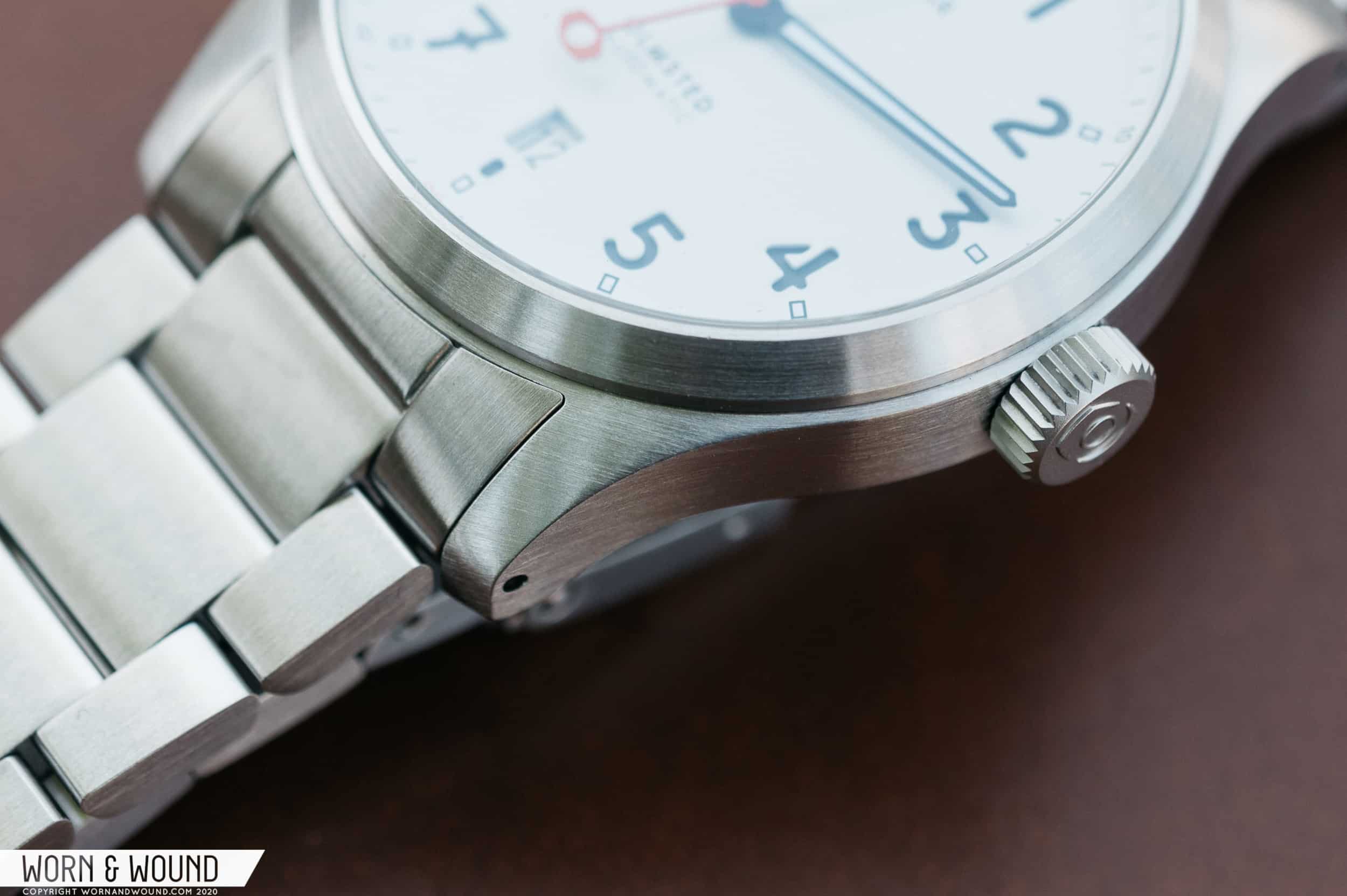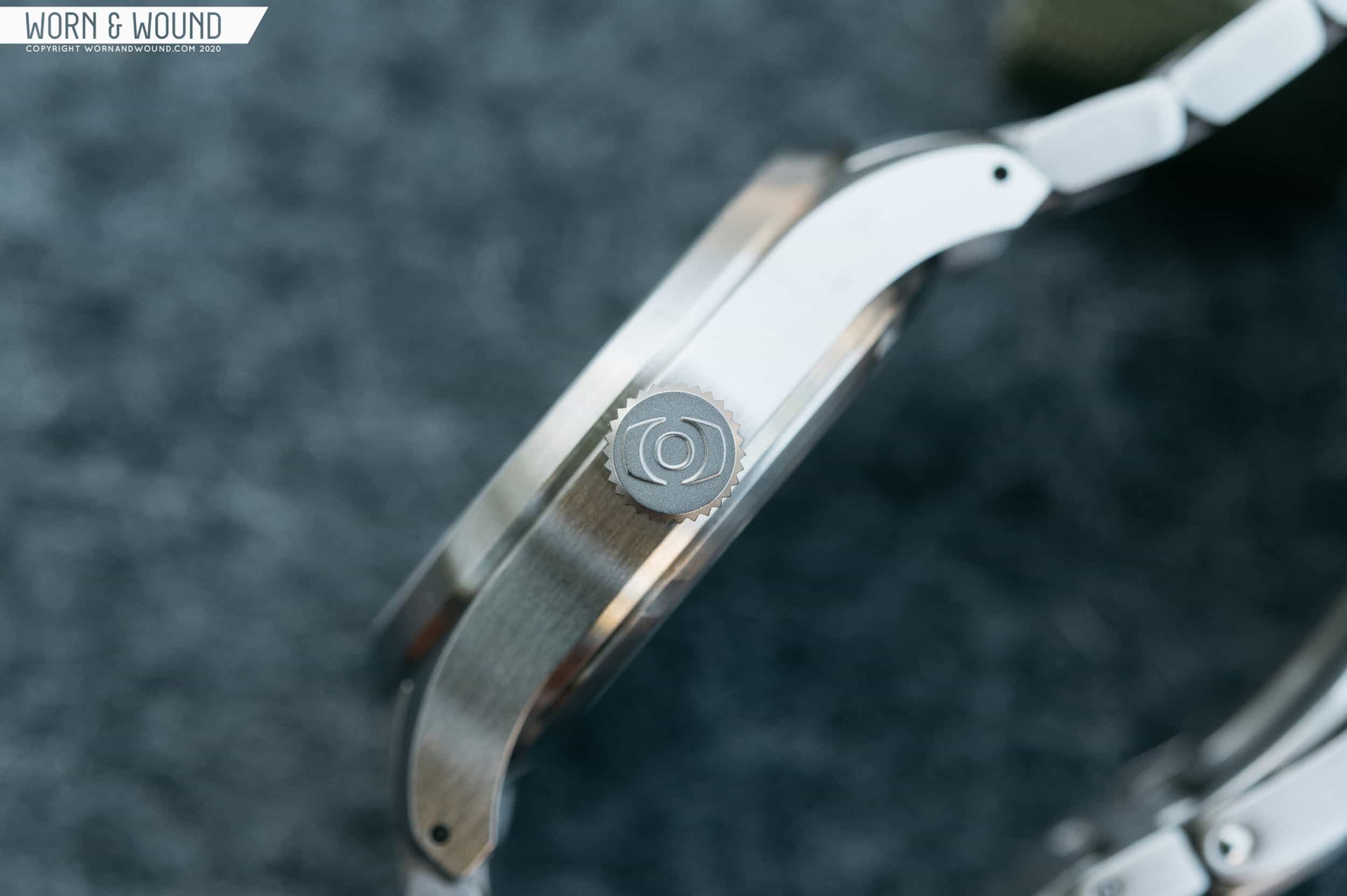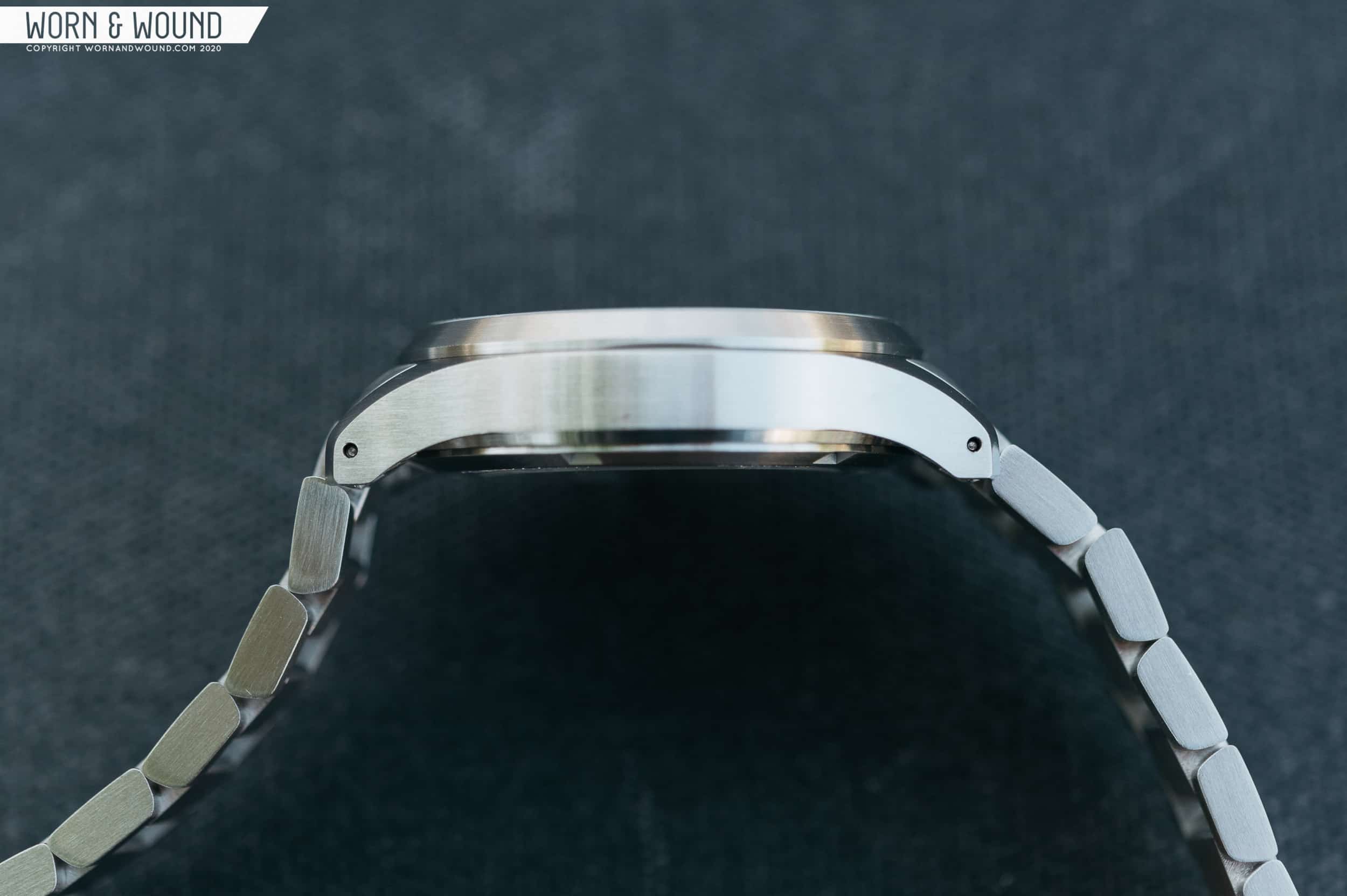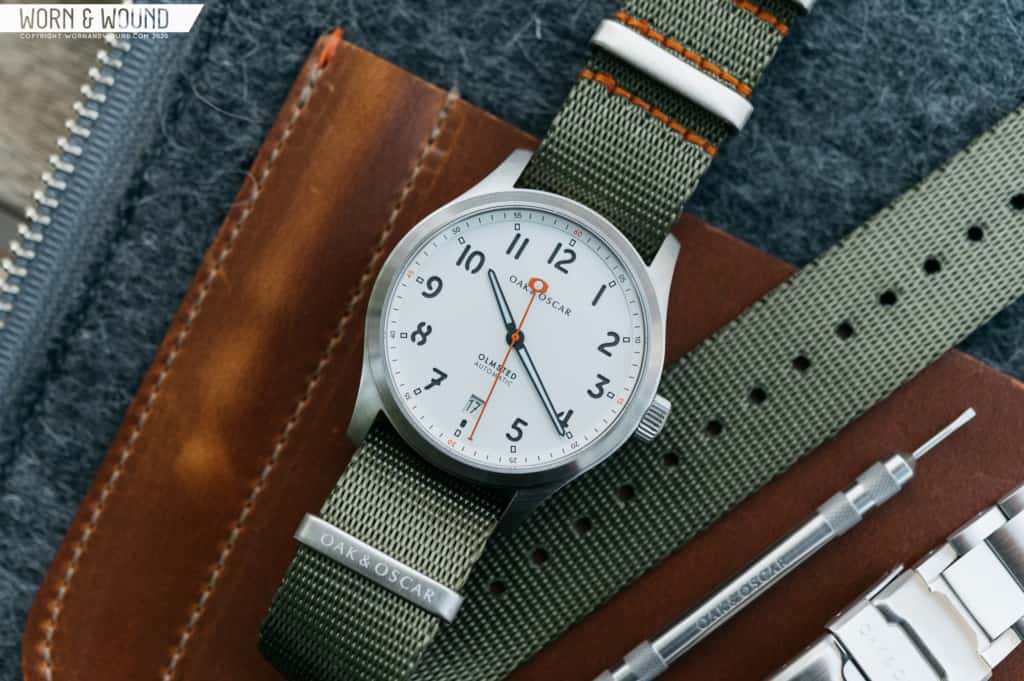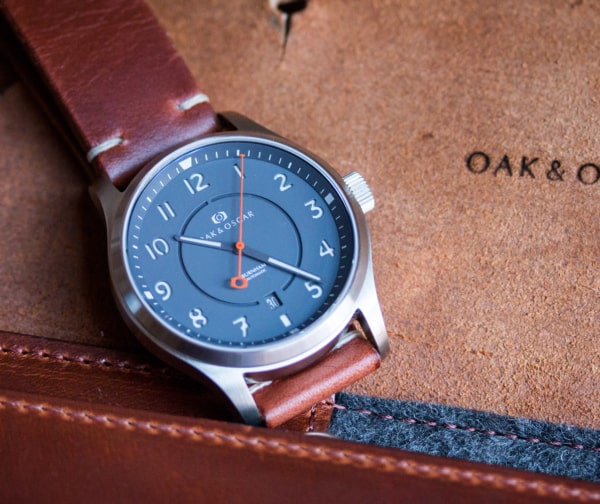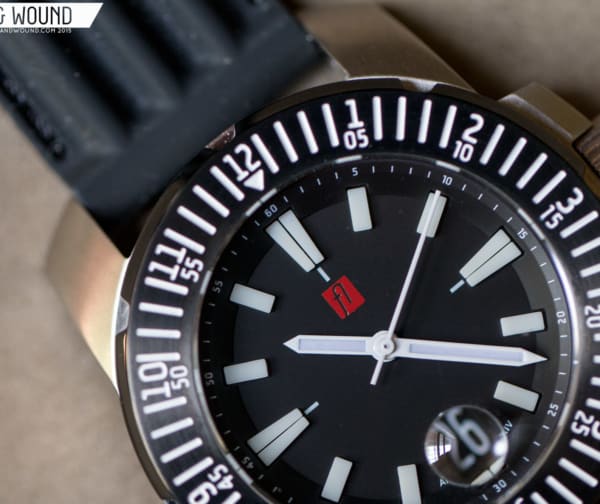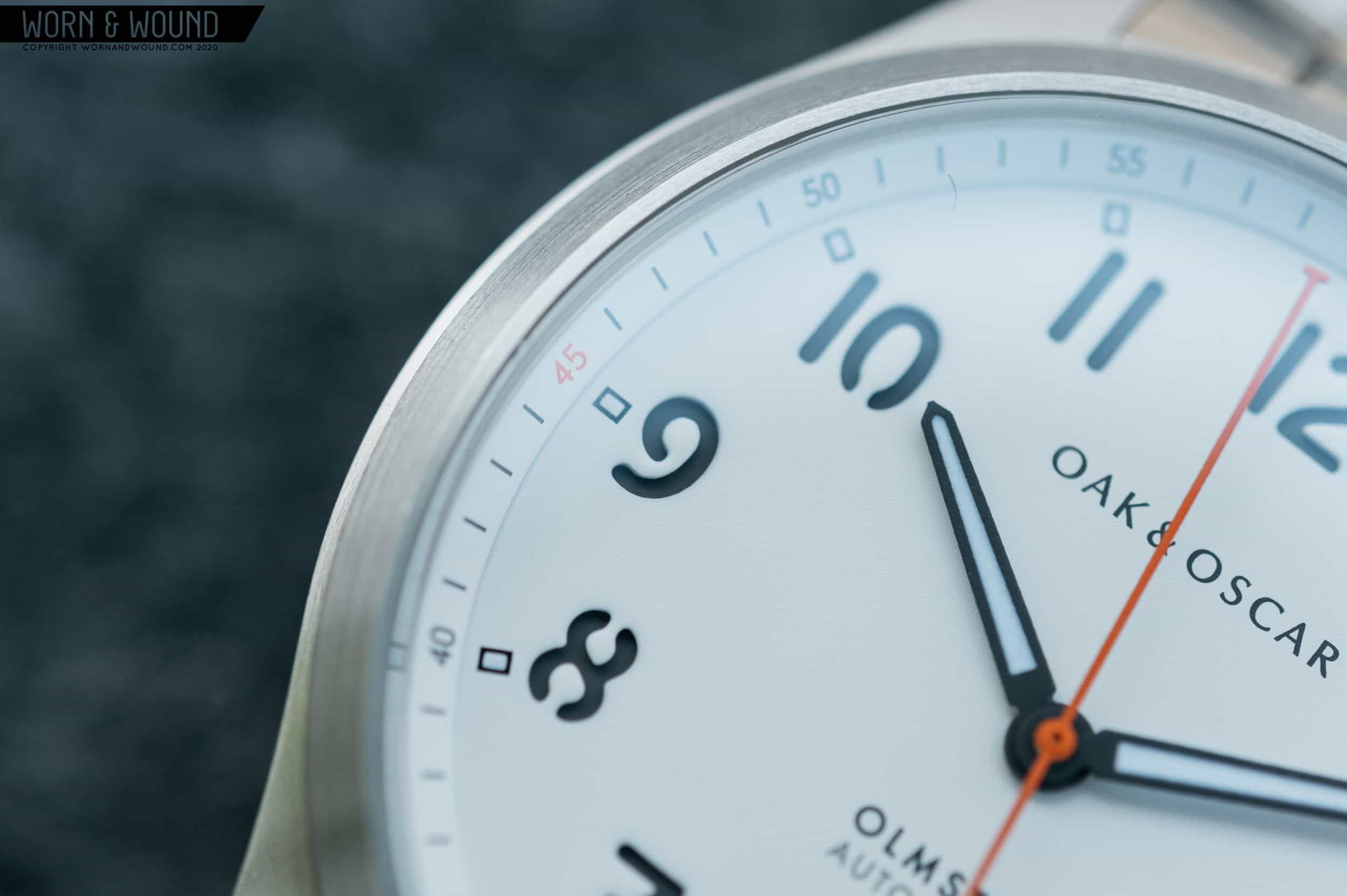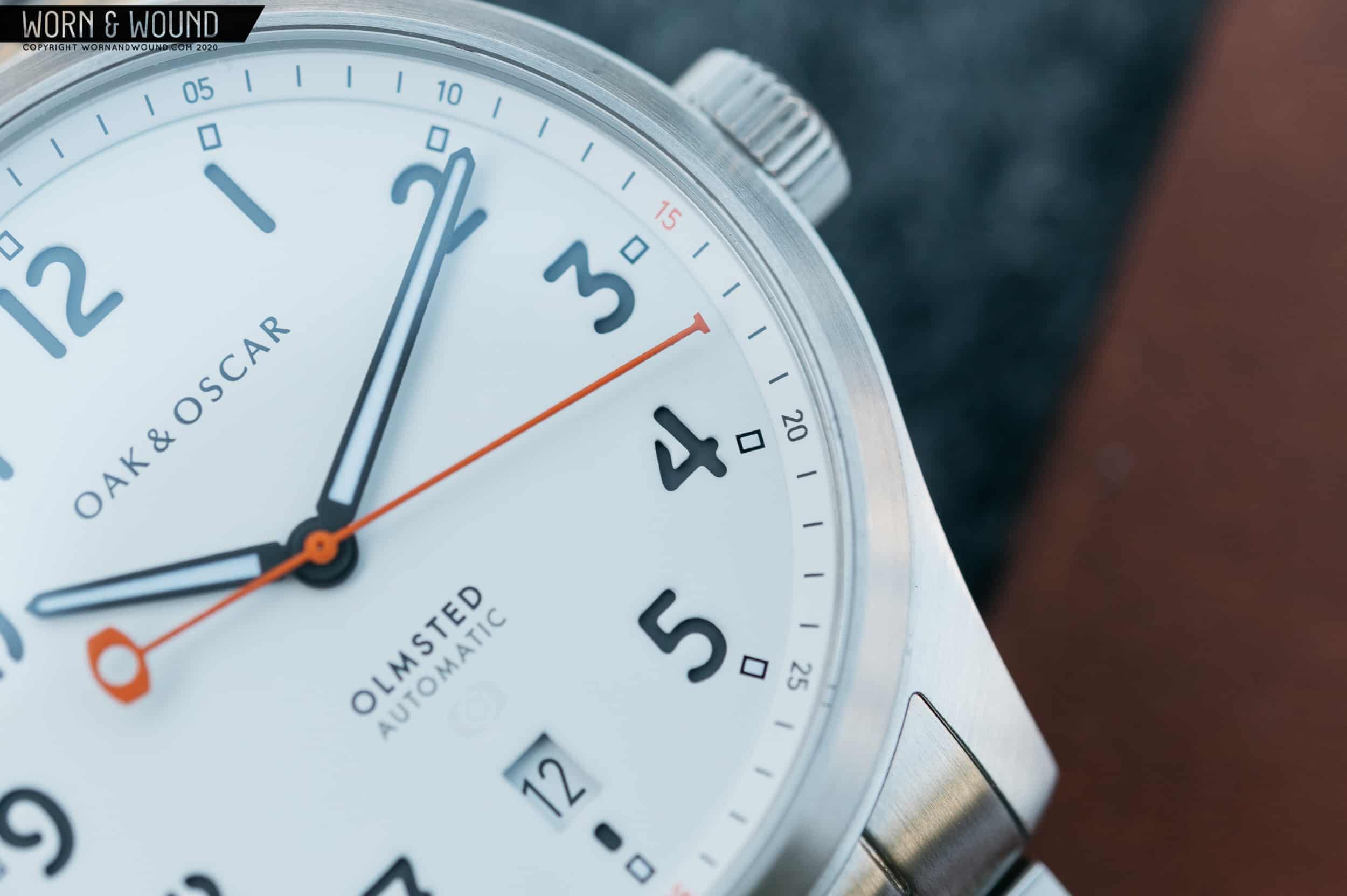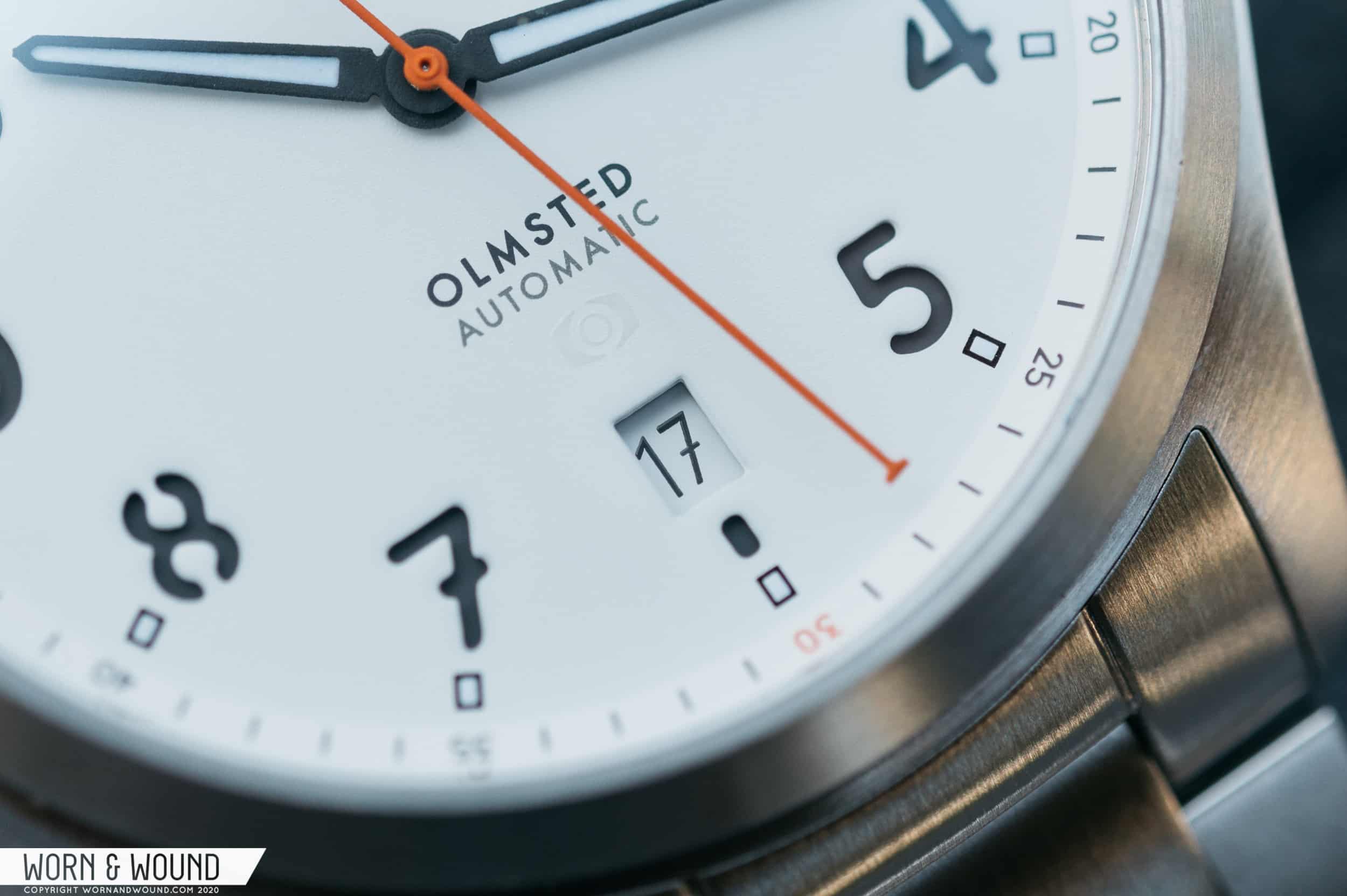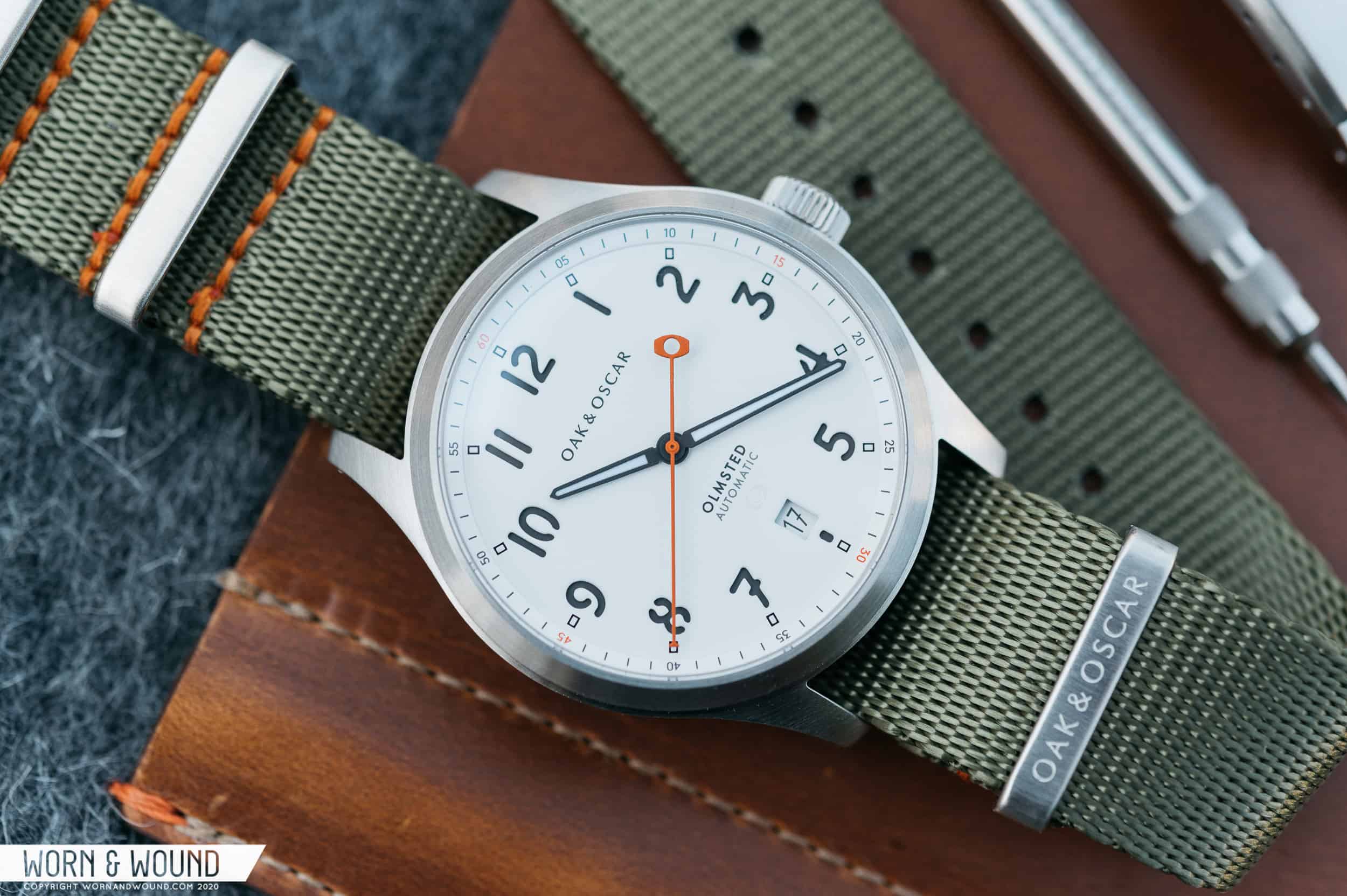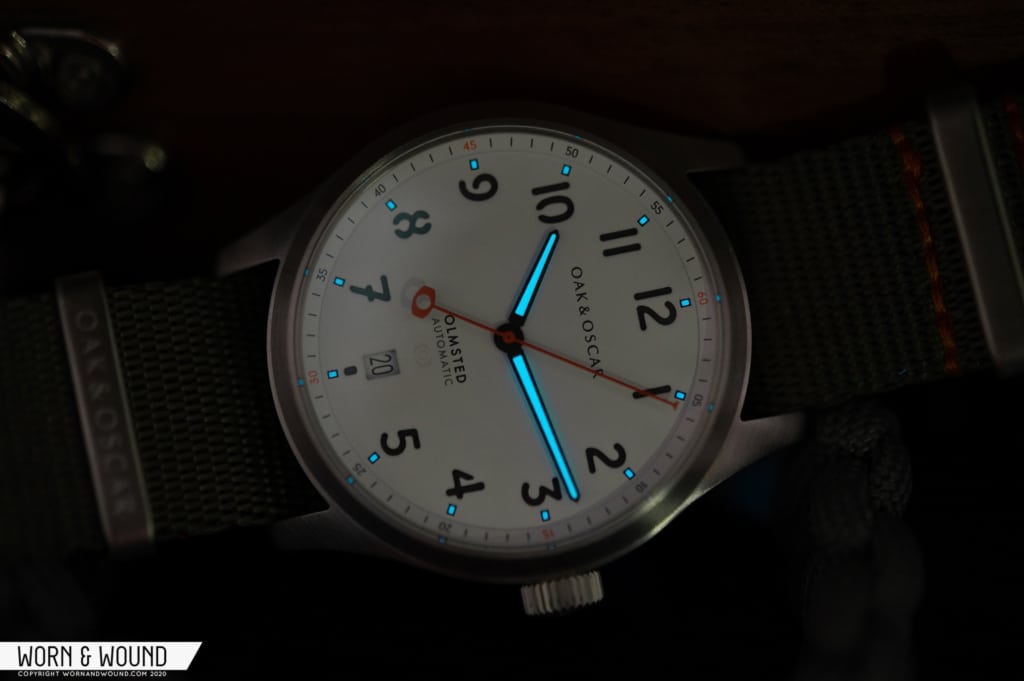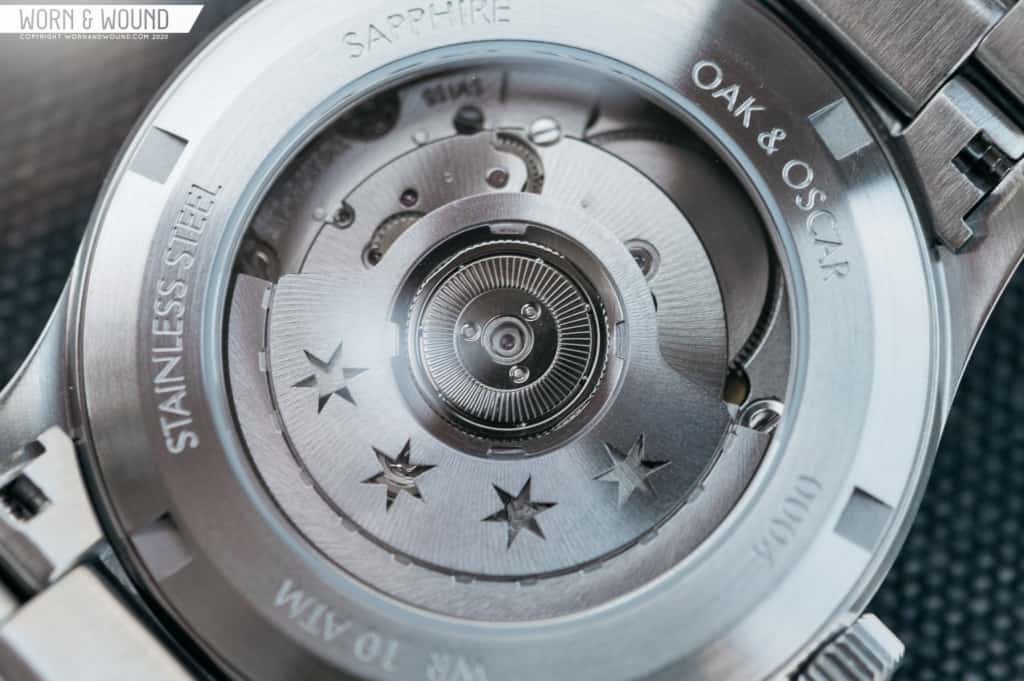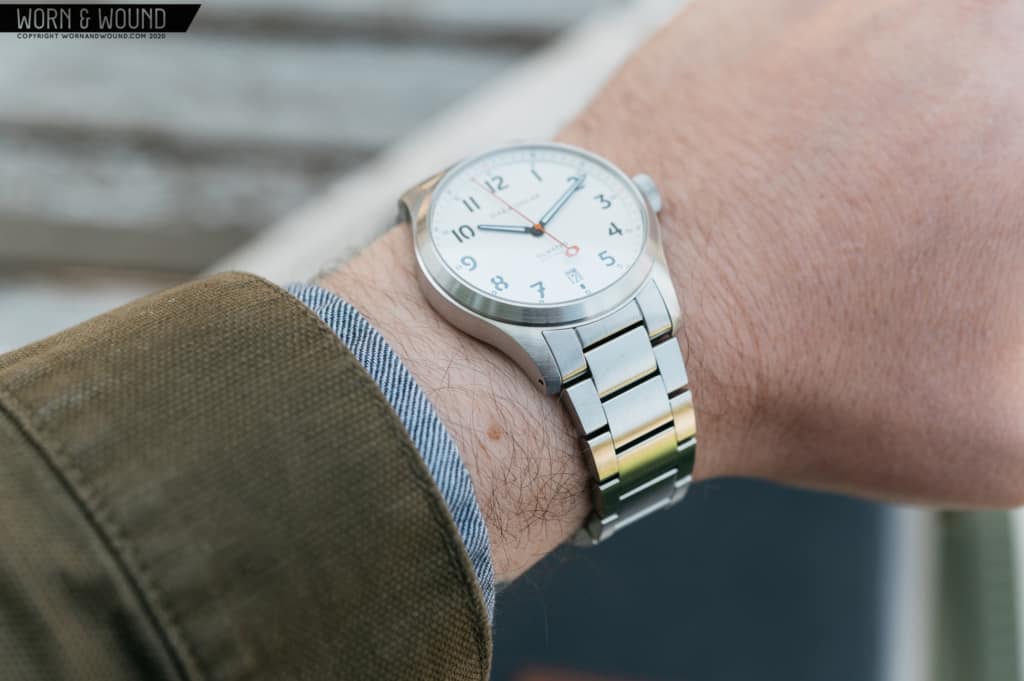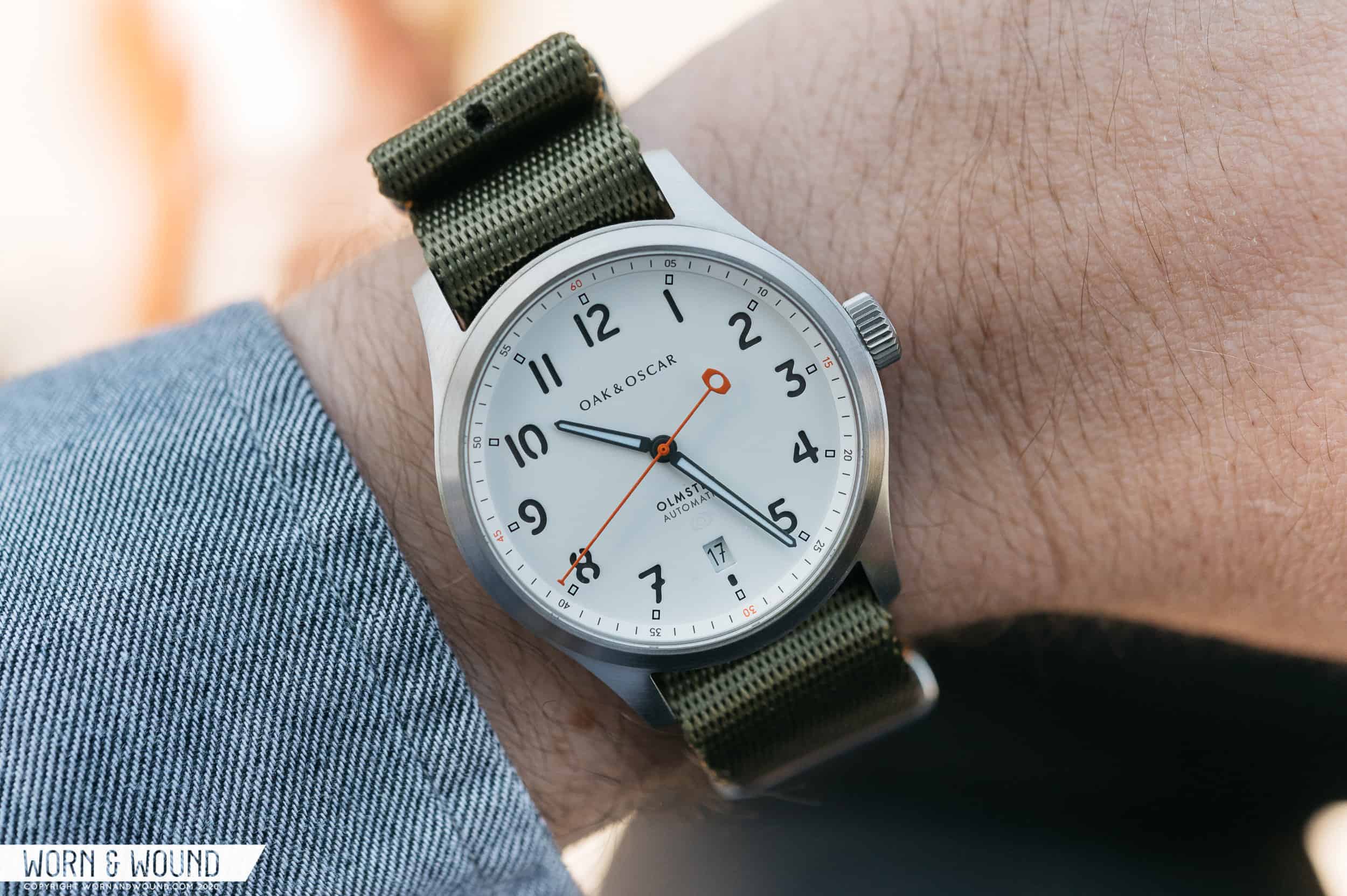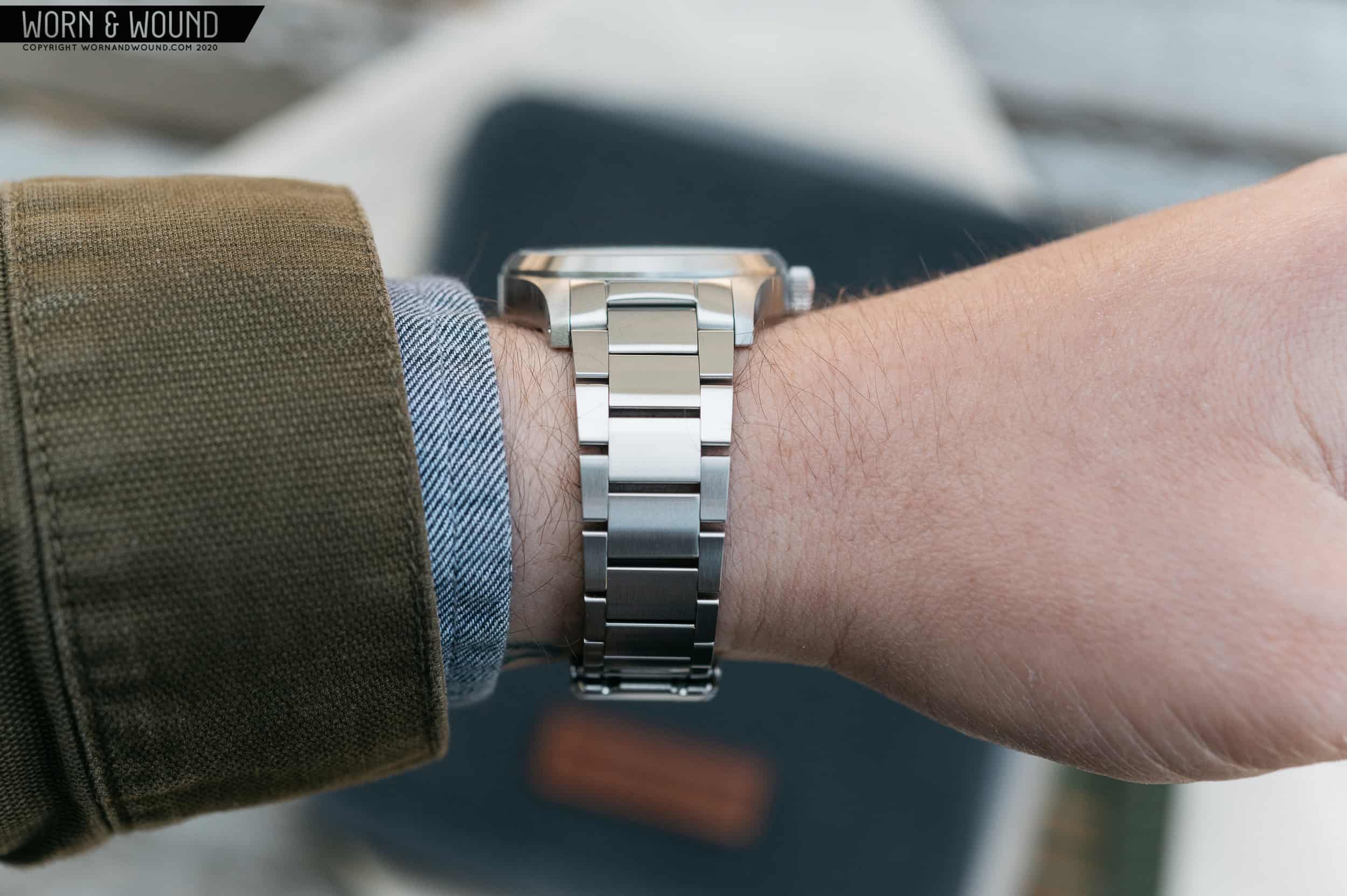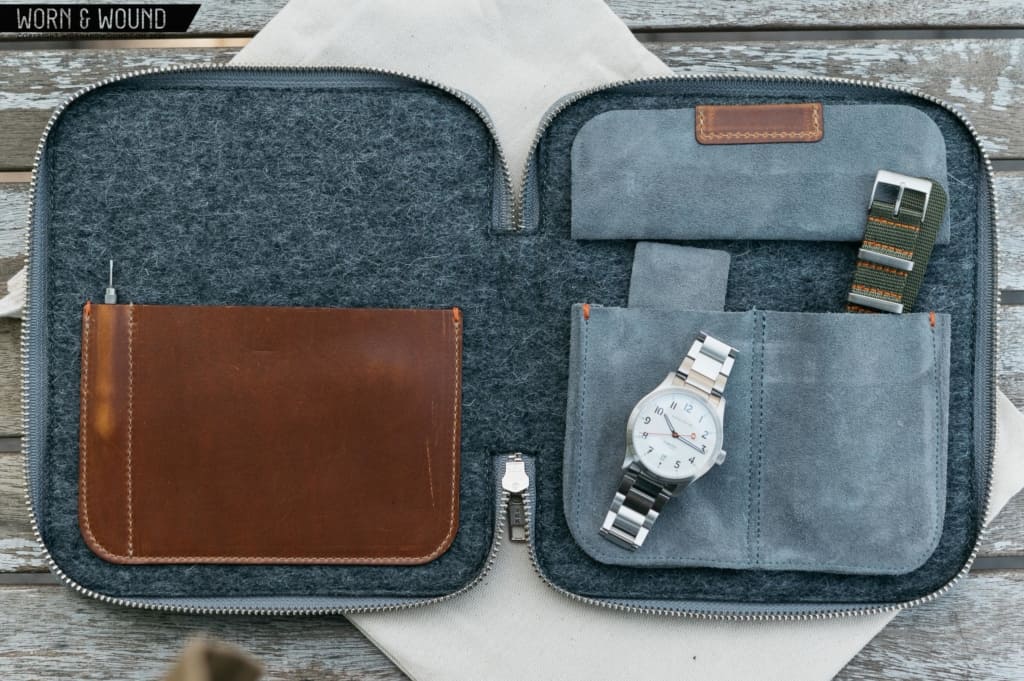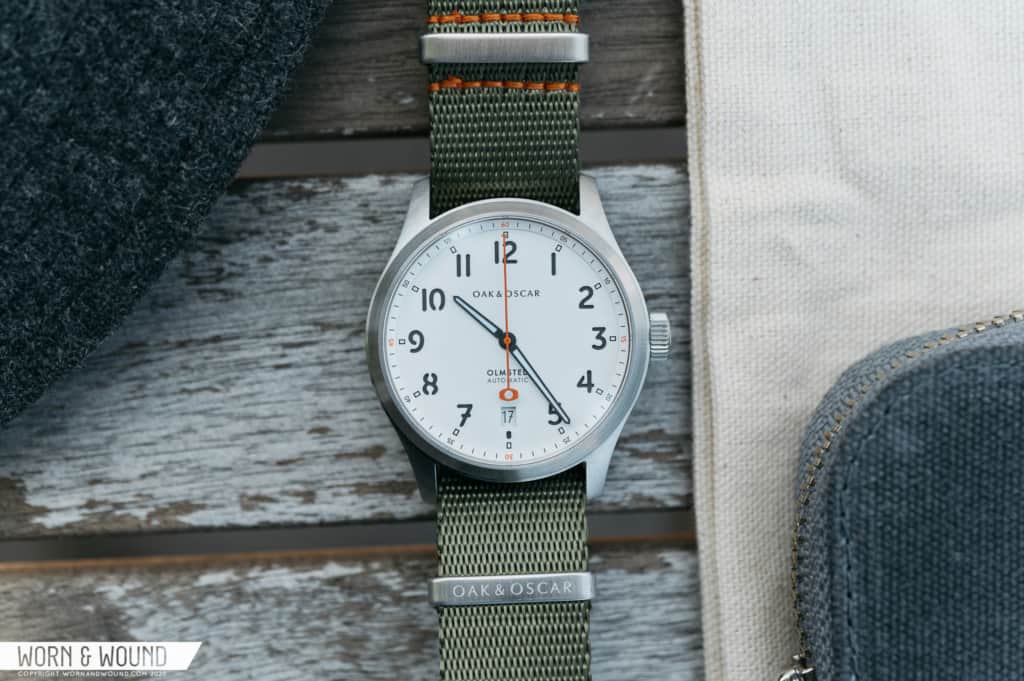Getting your hands on an Oak & Oscar watch in the past was probably a pain in the neck. By the time you did your pre-purchase research, there’s a good chance that the 200 piece lots would have already been sold out. For their first few watches, that was definitely the case, but it doesn’t carry over to the release of the Olmsted – a field-inspired, modern timepiece from the Chicago-based brand. It’s one of their two watches that are not limited to a small batch, always ready for purchase right on their beautifully-designed website. The Olmsted is housed in a 316L stainless steel case, with a grey, navy, or white sandwich dial with custom-designed numerals and a ton of small, yet tasteful touches that make the Olmsted a solid entry in the Oak & Oscar lineup. Let’s take a closer look at this mainstay in the lineup. First, some specs:
Review: Oak & Oscar Olmsted
Review: Oak & Oscar Olmsted
Case
38mm is the goldilocks size for a watch case. Not too big, not too small…just right. It’s big enough to have some nice presence on the wrist, but doesn’t rule smaller wrists out with a long lug-to-lug or crazy huge diameter. Machined from 316L stainless steel, the case features a very light brushing on all visible surfaces. The direction of the brushing follows the lines of the case, which helps to break up the design a bit. Finishing on the case is crisp, and the transitions between surfaces are sharp. There’s nothing too crazy about the case design, but there doesn’t have to be. It’s modern, sleek, and fits the aesthetic of the watch very well.
From the top-down, you’ll notice a slim, beveled circle of stainless steel surrounding the dial. It slopes from the crystal to the case at about 45º before transitioning to a short ~1mm vertical drop just before it meets the case. At 3 o’clock, there’s a grooved crown with Oak & Oscar’s barrel logo proudly displayed on the flat surface. Operating the crown is a dream. It’s silky smooth to unscrew, operate, and close again. It seats itself slightly into the case, which gives the crown a slimmer appearance as well.
In profile, the case’s 10.8mm height is divided up evenly between the bezel/crystal, mid-case, and case back. Since the sides are flat vertical slabs, the proportions from the side are crucial in balancing each other out. This balance avoids giving the watch a thick and chunky appearance. Oak & Oscar nailed it here, as no single element is out of balance with the other. There are also a few small details that I appreciate like drilled lugs for quick and easy strap changes, and a custom rotor on the movement that’s visible through the sapphire display case back.
Dial + Hands
Dial design is really where Oak & Oscar excels. Every element of the two-layer sandwich dial and hands are designed from the ground up. For a watch that looks so clean, there’s a surprising amount of different design elements going on. The impressive part is that they manage to work together to keep that minimal/clean look without imposing on each other. Let’s start by looking at the dial itself.
The watch sent for review is the white-dialed version. It’s also available in a handsome dark grey and a deep, yet muted navy. Each version shares the same general design, while the base color of the dial differs between models. The one feature I’m missing out on with the white dial is how the lume is applied. On the two darker versions, the bottom layer of the sandwich is lumed, while on the white dial, it’s a dark grey base. The lume is applied in small rectangular plots next to the numerals. It would be cool to have the lume sandwich effect on all of the models, but it would render the white dial illegible.
Lume application is more of a preference than a problem, and there’s plenty to love about the Olmsted’s dial. The standout feature has to be the custom 1-12 numerals running around the dial. Displayed in a custom typeface, each number is meticulously designed so that it has that Oak & Oscar look, while being functional as a cutout. The resulting effect is an open 4, 8, 9, and 10. Each numeral has a modern, stencil-like look that’s unique to the brand. In lieu of a “6”, there’s a date window with a custom wheel, with a custom typeface for the numerals and a background matching the dial’s base color.
A printed rehaut runs around the outside of the dial with a hashmark for each minute, and a small number every five. The cardinal numerals (in this case, 60, 15, 30, and 45) are rendered in a bright orange color that perfectly matches the seconds hand. Logo application and text are kept to a minimum, with Oak & Oscar’s name printed just under 12, while the model name and “automatic” are balancing it out at six. If you look very carefully between the word “automatic” and the date window, you’ll notice the brand’s barrel-style logo in a clear shiny print that just barely stands out on the matte dial. All of the cutouts and printing are perfect. Yes, perfect. They’re crisp, uniform, and without noticeable fault.
A watch’s main function is to tell the time, and you’ll have the pleasure of doing that by reading off Oak & Oscar’s three hands. The hour and minutes hands are slender and long, tapering slightly from the base to the edge of the dial, and terminating at a point. They’re outlined in the same deep grey as the base of the dial and filled with Swiss Super-Luminova BGW9 that gives off a teal-blue glow when the lights go out. Sweeping its way around the dial is the bright orange seconds hand. It’s one of the larger seconds hands I’ve seen on a watch this size, and it’s part of Oak & Oscar’s signature look. The longer end of the seconds hand terminates in a flat edge, and is counterbalanced by the “O” shaped barrel logo on the opposite end. It’s one of the standout features of the watch and adds a welcomed pop of color to what would be a monotone watch. Everything is protected by a double-domed sapphire glass with a multi-level AR coating. The dome is very slight, and it in no way affects the legibility of the dial.
Movement
The powerhouse inside the Olmsted is ETA’s caliber 2892-A2. It’s an automatic winding movement that tops out at 42 hours of power reserve. There are 21 jewels used throughout the movement. A beat rate of 28,800bph keeps that massive seconds hand sweeping around the dial smoothly. Oak & Oscar added their own custom rotor to the movement, which features four six-pointed stars. You really can’t go wrong with an ETA movement, and it makes sense in the Olmsted, especially considering the price. You can get a good glimpse of what’s going on inside through the display back, which is always a nice touch.
Straps + Wearability
You can choose from either a leather strap or a stainless steel bracelet when purchasing the Olmsted. The model I have on hand came with the steel bracelet, and I’m glad it did. While their leather straps look nice, I always prefer to pick up a watch with the bracelet. There are so many aftermarket options for straps, while a bracelet is usually more expensive (or unavailable) to add post-purchase. It’s clear that a lot of thought went into the Olmsted’s bracelet. It tapers from the lugs to the clasp and features fully articulated flat links that look like a modern update to the oyster-style bracelet. Since each piece of the link is hinged, the bracelet is very comfortable to wear, as it contours to your wrist a bit more than a standard oyster would. Although it doesn’t affect the function of the bracelet, there’s a rather large gap between links. I’m not sure if it’s by design or something that just comes along with the articulated links, but it looks a little off, especially when compared to other bracelets in the same style.
To keep it secured on your wrist is a pretty standard clasp with a fold-over locking component. One thing that’s worth mentioning is the high degree of adjustment for a fully custom fit. There are full and half links on the bracelet and five micro-adjust holes in the clasp that ensure a great fit on any wrist from 6.2” to 9.1” — an impressive range. The modern-looking oyster bracelet nicely complements the rest of the watch, easily justifying the $200 premium over the leather strap option.
Whether you choose the Olmsted on a leather strap or the steel bracelet, it comes with a nylon strap. In this case, its green seatbelt weave nylon with contrasting orange stitching. The hardware is brushed and one of the keepers is branded with Oak & Oscar’s logo. It’s a nice addition to the package. Putting the Olmsted on nylon changes up the look from a more business casual look to something that you could do some adventuring in. It speaks to the versatility of the Olmsted.
Packaging
Usually, packaging is something that’s glossed over. Most of the time, you get a box within a box, and it goes into closet purgatory until you decide to sell the watch, or chuck it before a move. That’s not the case with the Olmsted, and it’s a refreshing change of pace. Instead of a box, the watch ships in a custom-made waxed canvas wallet with room to store two watches. It’s no cheapy case either. The entire thing is made in Chicago by Stock Mfg. Co., and features Horween leather accents, suede watch pockets to prevent scratches, and a handsome wool felt lining. It’s something I’d happily reuse for travel, and it’s nice that they added a second watch pocket, even though you’re only buying one watch. As an owner of the “big box” Speedmaster Professional, it’d be nice to have something I could potentially use and enjoy, rather than a box that makes you consider renting a storage space to keep it in.
The case also adds to a nice unboxing experience. This is something that can easily be lost when your primary point of purchase is online. The box has custom tape with their “Make No Little Plans” slogan on it, and the watch pouch itself is bagged in a canvas dust bag along with a handwritten note. It’s a nice touch that really shows how Oak & Oscar puts care into making you feel like you’re part of a bigger community rather than that you’ve just purchased a watch.
Conclusion
Oak & Oscar is not just about buying the watch, it’s about the experience as well. Granted, as someone writing a review with a loaner watch, I didn’t get that full experience (it was still packaged up just like I had purchased it). But since I’ve been following the brand for some time now, it’s clear that they care about the people that own one of their creations. Whether it be the in-person appointments (which are currently moved over to video calls) to check out their watches, the virtual happy hours for their owners, and even just the attention to detail in packaging and presentation.
Of course, the watch is important too. The Olmsted is an excellent take on a modern field watch with a heavy emphasis on clean, functional design. It feels great on the wrist and looks just as sharp. If you’re in the market for a watch that looks just as good at the office as it does out on a day hike or jaunt into the city, the Olmsted easily fills that need. The Olmsted retails for $1375 on strap and $1575 on bracelet. It’s hard to comment on price, because the cost of a watch is relative to the purchaser, but there is a LOT of competition in the $1500 range that the Olmsted sits in. You can get a whole heck of a lot of watch for that price, including some great mechanical chronographs, German watches packed with tech, or some really classy dress watches with excellent finishing. The Olmsted is a rather simple watch that sits in a competitive price range, and there’s no getting around that. However, it does fit in well with the brand. Oak & Oscar has created a cohesive lineup of watches that are immediately (to me, at least) recognizable as their own. Between the Olmsted and the Humboldt, they’re off to a great start with their readily available, non-limited models, and I’m excited to see what’s next for the brand.
Oak & Oscar









 Featured Videos
Featured Videos




